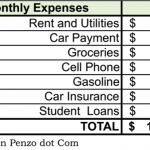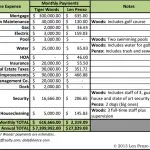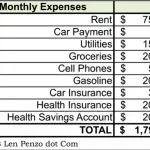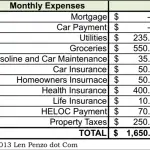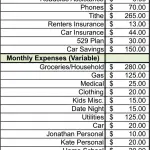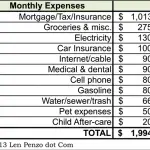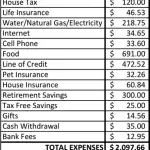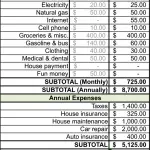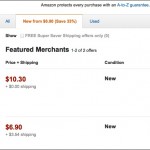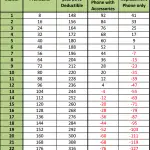My name is Lynsey and I'm 25-years-old with no children. I'm from Minnesota and have a bachelor's degree in Marketing and Business Management. I am currently employed in the marketing field.
I've always been pretty responsible with my money, ...
Continue reading How I Live on Less Than $40,000 Annually: Lynsey from Minnesota
Comparing Tiger Woods’ Home Carrying Costs to Mine
When it comes to holes-in-one, I always tell anyone who will listen that Tiger Woods has got nothing on me.
Did you know I recorded my first ace not long after reaching my 18th birthday, fully two months before Tiger got his first one? I ...
Continue reading Comparing Tiger Woods’ Home Carrying Costs to Mine
How I Live on Less Than $40,000 Annually: Kacy from Iowa
My name is Kacy and I'm currently employed full time as a leasing agent and resident manager for a community college property in Central Iowa.
I've always been financially responsible. My dad is very good with finances and he taught me to always ...
Continue reading How I Live on Less Than $40,000 Annually: Kacy from Iowa
How I Live on Less Than $40,000 Annually: Jeff from Washington
My name is Jeff and I've been reading Len's blog off and on for a couple of years now. I'm 55 years old.
After getting my high school diploma I spent six years in the military, and then followed up my service with a series of various jobs.
My ...
Continue reading How I Live on Less Than $40,000 Annually: Jeff from Washington
How I Live on Less Than $40,000 Annually: Jonathan from Ohio
My name is Jonathan. I'm 27 and I've been married to my wife, Kate, for almost four years. We have three girls, ages 3, 1, and a newborn.
After graduating from college, Kate worked for two years at a job that paid $35,000 annually. Then, after our ...
Continue reading How I Live on Less Than $40,000 Annually: Jonathan from Ohio
How I Live on Less Than $40,000 Annually: Tracie from North Carolina
My name is Tracie and I'm 30-years-old. I'm an associate chemist in coastal North Carolina. I have an eight-year-old son and I'm engaged to his dad.
I wasn't always financially responsible -- I was saddled with $10,000 in consumer debt. Twice.
Then ...
Continue reading How I Live on Less Than $40,000 Annually: Tracie from North Carolina
How I Live on Less Than $40,000 Annually: Ruth from Kansas
My name is Ruth and I'm a stay-at-home mom for our four kids. When our first child was born, I vowed to stay home as long as we could afford it. It's been 16 years and three more kids since then, and I'm still here.
I was always very frugal, ...
Continue reading How I Live on Less Than $40,000 Annually: Ruth from Kansas
How I Live on Less Than $40,000 Annually: Barb from Alberta
My name is Barb and I live in Alberta, Canada. I've been working in retail sales management for ten years. My income is just over $40,000 per year, although the climb to get there was very gradual.
I have a teenage daughter who lives with me. ...
Continue reading How I Live on Less Than $40,000 Annually: Barb from Alberta
How I Live on Less than $40,000 Annually: Mary from New Mexico
My name is Mary. I'm 58-years-old and I live in New Mexico. I've been working since I was 16 years old.
I have a bachelor's degree, as well as a master's degree. I was fortunate to attend college in the 1970s and 80s without accumulating any ...
Continue reading How I Live on Less than $40,000 Annually: Mary from New Mexico
How I Live on Less than $40,000 Annually: Caine from Colorado
A little about me. On the internet, I usually go by "Caine Volfram." No, that's not my real name. I also go by "Clockwork Gremlin."
I am largely unremarkable. Single white male, just turned 28, Irish descent (among others), living in rural ...
Continue reading How I Live on Less than $40,000 Annually: Caine from Colorado
Are You Smarter Than a 5th Grader? Guess Which Item Costs More.
Last night I was doing a little shopping on Amazon and I came across an item that was being offered for sale by two different vendors. Here was the price summary that appeared on my screen:
So, which item is the better bargain?
On first ...
Continue reading Are You Smarter Than a 5th Grader? Guess Which Item Costs More.
How I Live on Less than $40,000 Annually: Jen from Virginia
Readers: Welcome to the first installment of my new series featuring Len Penzo dot Com readers who make ends meet on roughly $40,000 per year -- or less. Originally, I was hoping to run one or two articles per month, but the initial response has been ...
Continue reading How I Live on Less than $40,000 Annually: Jen from Virginia
The Trouble with Buying Movie Tickets Over the Internet
We all come across things in life that are wildly popular, even though it makes little sense to us.
Take "Duck Dynasty" -- going into its fourth season, it's one of the hottest shows on cable television.
I recently watched a couple of episodes ...
Continue reading The Trouble with Buying Movie Tickets Over the Internet
Cheap Cooking: Fantastic Frugal Meal Ideas from Past and Present
I was on an extremely tight budget when I was in college, so I had cheap cooking down to a science.
Back then, dinner was number four on my list of priorities; right after tuition, beer, and rent -- in that order.
Many people on limited incomes ...
Continue reading Cheap Cooking: Fantastic Frugal Meal Ideas from Past and Present
Is Cell Phone Insurance Really Worth It?
Last month our previous cell phone contract finally expired. That made the Honeybee happy because it meant we could finally move to a new carrier with better coverage.
However, nobody was more excited than the kid with the fastest thumbs in the ...
Continue reading Is Cell Phone Insurance Really Worth It?
Yet Another Reason Why I Hate Buying Tickets from Ticketmaster
Most of you know I've had a hate/hate relationship with Ticketmaster for a long time now.
After all, this is the company that wrote the book on ridiculous consumer fees that, many people argue, only serve to exploit their hapless customers; it's a ...
Continue reading Yet Another Reason Why I Hate Buying Tickets from Ticketmaster
A Fun Interview with Stacking Benjamins’ Host, Joe Saul-Sehy
I recently met with Joe Saul-Sehy to talk about his new money podcast, Stacking Benjamins, which debuts this week. We had just finished recording his final Two Guys and Your Money show, and I figured it would be clever to conduct the interview via ...
Continue reading A Fun Interview with Stacking Benjamins’ Host, Joe Saul-Sehy
More Reasons Why I Decided to Buy a New Car Instead of a Used One
As I mentioned in my previous post, I finally relented and bought myself a new car.
I can understand why some of you may be scratching your head at my decision to buy new instead of used. Especially when the playbook of good personal finance ...
Continue reading More Reasons Why I Decided to Buy a New Car Instead of a Used One
I Finally Broke Down and Bought a New Car
OK, I did it.
After commuting to and from work in my 1997 Honda Civic for the past 13 years, and with my son on the verge of getting his driver's license, I finally relented and bought myself a new car.
That's right. I'm now the proud owner of ...
Continue reading I Finally Broke Down and Bought a New Car
How to Get the Best Travel Deal from Price Comparison Websites
Price comparison websites are a great resource for budget-conscious travelers, with many people skipping travel agents altogether and doing the flight booking themselves. Due to the huge growth in this type of website, there are now more price ...
Continue reading How to Get the Best Travel Deal from Price Comparison Websites
- « Previous Page
- 1
- …
- 138
- 139
- 140
- 141
- 142
- …
- 149
- Next Page »

